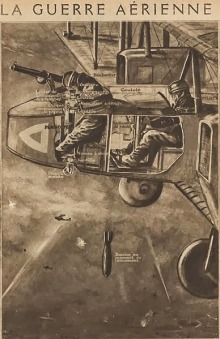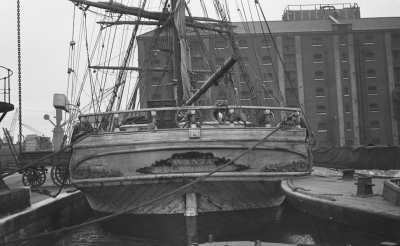♦♦♦♦♦♦♦♦♦♦♦♦♦♦♦♦♦♦♦♦♦♦♦♦♦♦♦♦♦♦♦♦♦♦♦♦♦♦♦
Rotherhithe is one of many areas of London (and indeed Britain as a whole) that suffered terribly in the Second World War, and the bomb damage is well recorded, but there are fewer details about Rotherhithe’s fate in the First World War. The Rotherhithe entry on Wikipedia, for example, has a paragraph about the Second World War, but makes no mention at all of the Great War. Nor is it mentioned on Southwark Council’s Rotherhithe History page. The Museum of London Docklands devotes almost no space to it. So why not? It is not that London wasn’t targeted between 1914 and 1918, because it was. In fact, aerial warfare was virtually invented during this period, with airships and then early warplanes being employed to drop bombs. The answer seems to come into three parts. The first is that although London had been identified as a legitimate target by Germany, the technology was too basic to inflict anything like the damage in the Second World War, and the weather created problems that the fragile aircraft could not overcome. Second, the docks were not identified as a key strategic target in the First World War, whereas in the Second, all the docks were seen as key, and the damage inflicted was staggering, overshadowing anything inflicted between 1914 and 1918. With particular reference to Rotherhithe, the third reason that we never hear about bomb damage locally from the First World War is that the few bombs that did fall on Rotherhithe and in neighbouring created minor damage, caused much less significant harm than other bombs that fell, by accident or design, during the same raids in other residential and commercial areas.
With all those caveats in mind, bombs did fall in Rotherhithe. You can see more about these on a post on my Rotherhithe blog, but those that came close to South Dock were as follows: On 4th/5th September two bombs on Millwall Docks, just across the water from South Dock. On the first day of the Harvest Moon offensive one of three Gotha bombers that managed to reach London on 24th September 1917 dropped explosive and incendiary bombs the East India Dock Road, the West India Docks, Rotherhithe and Deptford before it headed back east through Poplar. Of these, three explosive bombs hit Rotherhithe just south of Evelyn Street just to the east of Plough Way, and another hit right at the apex of Rotherhithe peninsula apparently just west of the lock entrance into Lavander Pond, possibly in the vicinity of where the St Paul’s sports ground is now located. On the night of October 31st, under a full moon, a Gotha came up from a bombing raid in the Streatham and Tooting area, bombing Deptford, Surrey Docks, Millwall Docks and Plaistow before heading out to the coast. This was supposed to be part of a firestorm offensive, in which incendiaries dropped all over London would create a blanket of fires. Fortunately, the plan failed, and there were very few deaths that night.
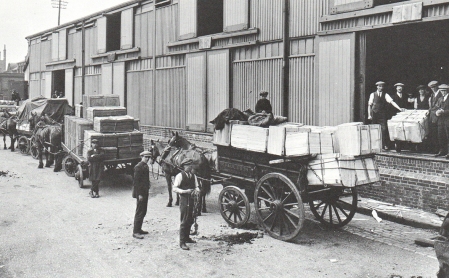
Paper being loaded from no.3 Warehouse at South Dock in the 1920s. From Elmers and Werner “Docklands Life”
In the inter-war years, South Dock continued to be of great value to the docks. Regular visitors were ships of the Finnish Line, and was also of value for letting smaller ships access the system. Although ship building had changed radically since the mid 1800s, with the introduction of steam, and then the innovation of iron hulls, wooden sailing ships continued to transport timber until quite late. They were used as a low-cost option when neither speed nor a specific arrival date were of importance, and continued to provide a useful service. Their use did not survive the horrors of two consecutive Word Wars.
The above photograph, taken by prolific dockland author A.G. Linney, shows one of the South Dock warehouses, still standing in 1932. These buildings survived the First World War, but not the Second World War. The First World War was much less damaging to the Thames docks than the Second.
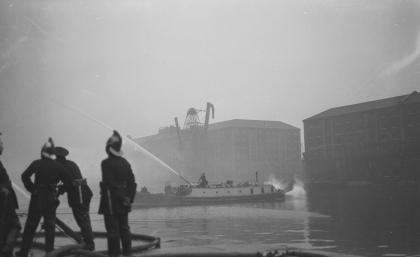
Firemen fighting a fire in South Dock on 8th March, 1936. A fire float monitor directs a jet of water from the middle of the basin. By A.G. Linney. Museum of London 2012.28/261
The German bombing raids during the Second World War, however, were devastating and effectively removed South Dock from the Surrey Commercial Dock network. The airship and aircraft bombings of the First World War did not damage the dock, but it fell victim to the more intense and targeted Luftwaffe bombing of the Second World War. The lock was badly damaged and was sealed until after the war. In 1944 the connection with Steelyard Cut was sealed off, the dock was drained, the floor was spread with rubble and the dock was used for the construction of concrete sections for Mulberry Harbour units. Mulberry Harbours were modular units which, when assembled, were used to create temporary harbours. They were used for the Normandy beach landings. When they were complete, Steelyard Cut was re-opened, the dock was refilled via Greenland Dock, and the sections were floated out onto the Thames through Greenland Dock’s entrance lock. There is a dedicated page about the Mulberry Harbours on this site, which you can reach by clicking here, or from the drop-down menu above. Warehouses were also hit, and one of the more notable casualties of the bombings was the Dog and Duck public house (which also has a page on this website, here). The pub sat at the Thames end of South Dock and had been there in some form since at least 1723. All that remains of it is the name of the Dog and Duck staircase, one of a whole series of watermen’s stairs that are found all along Rotherhithe’s foreshore.
After the war, South Dock’s entrance lock was repaired and warehouses were replaced, but even though they experienced a brief revival, the Surrey Commercial Docks never fully recovered, for a number of reasons that combined to cause the slow demise of the Rotherhithe docks.
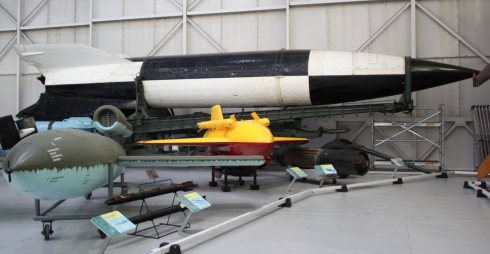
A V1 bomb in the foreground (green) and a V2 bomb in the background (black and white). Photos taken at the RAF Museum at Cosworth.
For the next part of the story click here: Mulberry Harbours in South Dock

